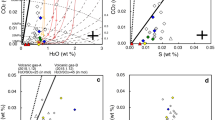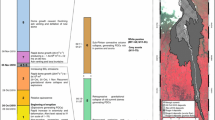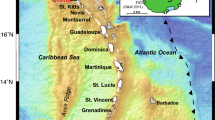Abstract
Among the series of eruptions at Miyakejima volcano in 2000, the largest summit explosion occurred on 18 August 2000. During this explosion, vesiculated bombs and lapilli having cauliflower-like shapes were ejected as essential products. Petrological observation and chemical analyses of the essential ejecta and melt inclusions were carried out in order to investigate magma ascent and eruption processes. SEM images indicate that the essential bombs and lapilli have similar textures, which have many tiny bubbles, crystal-rich and glass-poor groundmass and microphenocrysts of plagioclase, augite and olivine. Black ash particles, which compose 40% of the air-fall ash from the explosion, also have similar textures to the essential bombs. Whole-rock analyses show that the chemical composition of all essential ejecta is basaltic (SiO2=51–52 wt%). Chemical analyses of melt inclusions in plagioclase and olivine phenocrysts indicate that melt in the magma had 0.9–1.9 wt% H2O, <0.011 wt% CO2, 0.04–0.17 wt% S and 0.06–0.1 wt% Cl. The variation in volatile content suggests degassing of the magma during ascent up to a depth of about 1 km. The ratio of H2O and S content of melt inclusions is similar to that of volcanic gas, which has been intensely and continuously emitted from the summit since the end of August 2000, indicating that the 18 August magma is the source of the gas emission. Based on the volatile content of the melt inclusions and the volcanic gas composition, the initial bulk volatile content of the magma was estimated to be 1.6–1.9 wt% H2O, 0.08–0.1 wt% CO2, 0.11–0.17 wt% S and 0.06–0.07 wt% Cl. The basaltic magma ascended from a deeper chamber (∼10 km) due to decrease in magma density caused by volatile exsolution with pressure decrease. The highly vesiculated magma, which had at least 30 vol% bubbles, may have come into contact with ground water at sea level causing the large explosion of 18 August 2000.










Similar content being viewed by others
References
Amma-Miyasaka M, Nakagawa M (2002) Origin of anorthite and olivine megacrysts in island-arc tholeiites: petrological study of 1940 and 1962 ejecta from Miyake-jima volcano, Izu-Mariana arc. J Volcanol Geotherm Res 117:263–283
Amma-Miyasaka M, Nakagawa M, Nakada S (2005) Magma plumbing system of the 2000 eruption at Miyakejima volcano, Izu-Mariana arc. Bull Volcanol (this issue)
Anderson AT, Newman S, Williams SN, Druitt T, Skirius C, Stolper E (1989) H2O, CO2, Cl, and gas in Plinian and ash-flow Bishop rhyolite. Geology 17:221–225
Dixon JE, Stolper E, Holloway JR (1995) An experimental study of water and carbon dioxide solubilities in Mid-ocean ridge basaltic liquids. Part I: Calibration and solubility models. J Petrol 36:1607–1631
Gerlach TM, Graeber EJ (1985) Volatile budget of Kilauea volcano. Nature 313:273–277
Gerlach TM (1986) Exsolution of H2O, CO2, and S during eruptive episodes at Kilauea volcano, Hawaii. J Geophys Res 81:12177–12185
Geshi N, Shimano T, Chiba T, Nakada S (2002a) Caldera collapse during the 2000 eruption of Miyakejima Volcano. Bull Volcanol 64:55–68
Geshi N, Shimano T, Nagai M, Nakada S (2002b) Magma plumbing system of the 2000 eruption on Miyakejima volcano, Japan (in Japanese with English abstract). Bull Volcanol Soc Jpn 47:419–434
Hasegawa I, Ito K, Ono K, Aihara K, Kusunose K, Satoh T (1987) Crustal structure of Izu-Oshima island revealed by explosion seismic measurements—a profile across the island (in Japanese with English abstract). Bull Geol Surv Jpn 38:741–753
Hirabayashi J, Ossaka J, Ozawa T, Yoshida M (1984) Change in chemical composition of volcanic gases, and sublimates collected after the 1983 eruption of Miyakejima (in Japanese with English abstract). Bull Volcanol Soc Jpn 29:S308–S318
Holloway JR (1981) Volatile interactions in magmas. In: Newton RC, Navrotsky A, Woods BJ (eds) Thermodynamics of minerals and melts. Advances in physical geochemistry, Vol. 1. Springer, Berlin Heidelberg New York, pp 273–293
Housh TB, Luhr JF (1991) Plagioclase-melt equilibria in hydrous systems. Am Mineral 76:477–492
Itoh J, Takada A (2001) Chronology and deposits of Aug. 18 eruption event in Miyakejima 2000 eruption. Japan Earth and Planetary Science Joint Meeting Abstract: V0-P016
Japan Meteorological Agency (2000) Recent seismic activity in the Miyakejima and Niijima-Kozushima region, Japan—the largest earthquake swarm ever recorded. Earth Planet Space 52:i–viii
Kaneko T, Yasuda A, Shimano T, Nakada S, Fujii T, Kanazawa T, Nishizawa A, Matsumoto Y (2005) Subaqueous flank eruption preceding the caldera subsidence during the 2000 eruption at Miyakejima. Bull Volcanol (this issue)
Kazahaya K, Shinohara H, Uto K, Odai M, Nakahori Y, Mori H, Miyashita M, Hirabayashi J (2004) Gigantic SO2 emission from Miyakejima volcano, Japan, caused by caldera collapse. Geology 32:425–428
Kokelaar P (1986) Magma–water interactions in subaqueous and emergent basaltic volcanism. Bull Volcanol 48:275–289
Lowenstern JB, Mahood GA (1991) New data on magmatic H2O contents of pantellerites, with implications for petrogenesis and eruptive dynamics at Pantelleria. Bull Volcanol 54:78–83
Miyagi I, Tomiya A (2002) Estimation of heated temperature of volcanic ash based on the color change: an application to the landing temperature of the Miyakejima volcanic bomb ejected on 18 August 2000 (in Japanese with English abstract). Bull Volcanol Soc Jpn 47:757–761
Moore JG, Schilling JG (1973) Vesicles, water, and sulfur in Reykjanes Ridge basalts. Contrib Mineral Petrol 41:105–118
Nakada S, Nagai M, Kaneko T, Nozawa A, Suzuki-Kamata K (2005) Chronology and products of the 2000 eruption at Miyakejima. Bull Volcanol (this issue)
Newman S, Lowenstern JB (2002) VolatileCalc: a silicate melt-H2O–CO2 solution model written in Visual Basic for EXCEL. Comput Geosci 28:597–604
Nishimura T, Ozawa S, Murakami M, Sagiya T, Tada T, Kaizu M, Ukawa M (2001) Crustal deformation caused by magma migration in the northern Izu Islands, Japan. Geophys Res Lett 19:3745–3748
Saito G, Kazahaya K, Shinohara H, Stimac J, Kawanabe Y (2001) Variation of volatile concentration in a magma system of Satsuma-Iwojima volcano deduced from melt inclusions analyses. J Volcanol Geotherm Res 108:11–31
Saito G, Stimac JA, Kawanabe Y, Goff F (2002) Mafic-felsic interaction at Satsuma-Iwojima volcano, Japan: evidence from mafic inclusions in rhyolites. Earth Planets Space 54:303–325
Sakai S, Yamada T, Ide S, Mochizuki M, Shiobara H, Urabe T, Hirata N, Shinohara M, Kanazawa T, Nishizawa A, Fujie G, Mikada H (2001) Magma migration from the point of view of seismic activity in the volcanism of Miyakejima Island in 2000 (in Japanese with English abstract). J Geogr 110:145–155
Satoh H, Shimizu T, Shinohara H (2001) S and O isotopic systematics of the 2000 eruptions of Miyakejima volcano. Japan Earth and Planetary Science Joint Meeting Abstract: V0-P018
Sheridan MF, Wohlets KH (1983) Hydrovolcanism: basic considerations and review. In: Sheridan MF, Barberi F (eds) Explosive volcanism. J Volcanol Geotherm Res 17:1–29
Shinohara H, Kazahaya K, Saito G, Fukui K, Odai M (2003a) Variation of CO2/SO2 ratio in volcanic plumes of Miyakejima: stable degassing deduced from heliborne measurements. Geophys Res Lett 30:1208
Shinohara H, Fukui K, Kazahaya K, Saito G (2003b) Degassing process of Miyakejima volcano: implications of gas emission rate and melt inclusion data. In: De Vivo B, Bodnar RJ (eds) Melt inclusions in volcanic systems, methods, applications and problems. Elsevier, Amsterdam, pp 147–161
Soya T, Uto K, Makimoto H, Kamata H, Okumura K, Suto S (1984) Bulk and mineral chemistry of lavas and ejecta of the 1983 eruption of Miyakejima volcano (in Japanese with English abstract). Bull Volcanol Soc Jpn 29:S283–S296
Toda S, Stein RS, Sagiya T (2002) Evidence from the AD 2000 Izu islands earthquake swarm that stressing rate governs seismicity. Nature 419:58–61
Togashi S (1989) XRF Analytical Report 1/89. Determination of major elements in igneous rocks using Sc/Mo dual anode tube. Open-file Report. Geol Surv Jpn 132:1–35
Tomiya A, Miyagi I, Hoshizumi H, Yamamoto T, Kawanabe Y, Satoh H (2001) Essential material of the March 31, 2000 eruption of Usu volcano: implication for the mechanism of the phreatomagmatic eruption (in Japanese with English abstract). Bull Geol Surv Jpn 52:215–229
Tsukui M, Niihori K, Kawanabe Y, Suzuki Y (2001) Stratigraphy and formation of Miyakejima volcano (in Japanese with English abstract). J Geogr 110:156–167
Tsukui M, Niihori K, Kawanabe Y (2002) The 2000 AD subsidence caldera at Miyakejima volcano, Izu Arc, Japan (in Japanese with English abstract). Bull Earthq Res Inst Univ Tokyo 77:27–42
Uto K, Kazahaya K, Saito G, Itoh J, Takada A, Kawanabe Y, Hoshizumi H, Yamamoto T, Miyagi I, Tomiya A, Satoh H, Hamazaki S, Shinohara H (2001) Magma ascending model of 2000 Miyakejima eruptions: evidence from Pyroclastics of August 18 and SO2-rich volcanic gas (in Japanese with English abstract). J Geogr 110:257–270
Walker GPL (1989) Gravitational (density) controls on volcanism, magma chambers and intrusions. Aust J Earth Sci 36:149–165
Acknowledgments
We thank Drs. J. Itoh and A. Takada (GSJ) for providing rock samples and information on the 18 August 2000 eruption, Dr. S. Nakano (GSJ) for whole-rock data on previous eruptions of Miyakejima volcano, Drs I. Miyagi and A. Tomiya (GSJ) for helpful comments on melt inclusions and thermal constraints on the magma. This manuscript was greatly improved with critical and constructive comments from Drs. T. Druitt, T. Wright, L. Francalanci and an anonymous reviewer
Author information
Authors and Affiliations
Corresponding author
Additional information
Editorial responsibility: S. Nakada, T. Duitt
An erratum to this article can be found at http://dx.doi.org/10.1007/s00445-005-0431-9
Rights and permissions
About this article
Cite this article
Saito, G., Uto, K., Kazahaya, K. et al. Petrological characteristics and volatile content of magma from the 2000 eruption of Miyakejima Volcano, Japan. Bull Volcanol 67, 268–280 (2005). https://doi.org/10.1007/s00445-004-0409-z
Received:
Accepted:
Published:
Issue Date:
DOI: https://doi.org/10.1007/s00445-004-0409-z




